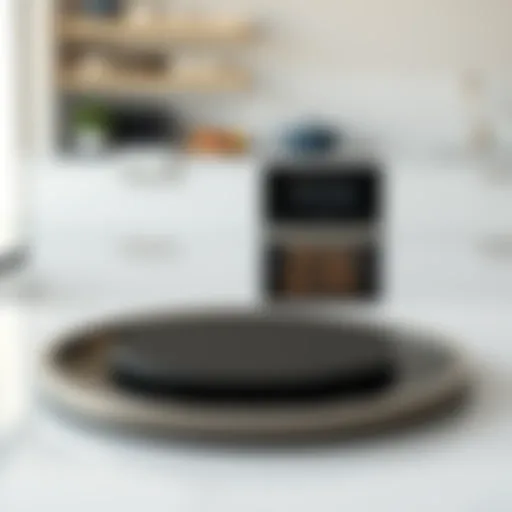Transform Your Space: Living Room Accessories Guide


Intro
Creating a warm and inviting living room is no small feat. In fact, the choices you make regarding accessories can significantly impact the overall feel of the space. Accessories can range from art pieces to decorative pillows, each bringing a unique touch that complements your interior design. They can also serve functional purposes, enhancing the usability of the room while making it visually appealing.
In this discussion, we’ll explore how living room decoration accessories can transform your space, the current design trends shaping the industry, and practical suggestions to weave personal style into modern aesthetics. Whether aiming for a chic, contemporary vibe or a cozy, eclectic feel, understanding the art behind these decoration choices can improve not only the appearance of your living room, but also how it feels to inhabit the space.
Design Trends
Decorating your living room is not just about throwing on a couple of cushions or hanging a picture. It's a strategic process that requires an eye for current trends while ensuring harmony in the overall décor.
Contemporary Styles
Contemporary design is always evolving, incorporating elements of minimalism alongside bold expressions of personality. Think about mixing vintage finds with sleek, modern furniture styles. Minimalistic art pieces can elevate the ambience without overwhelming the senses.
Additionally, materials such as natural wood, metal, and sustainable textiles are being embraced more than ever. For instance, using reclaimed wood for accessories can tell a story, while avoiding mass-produced plastic elements signals a commitment to sustainability.
Color Palettes and Materials
Color choices lay the foundation for any room. Earthy hues, soft pastels, and vibrant jewel tones each tell a different story about the room’s character. A subtle palette provides a calm atmosphere, while bold colors can energize the space.
When it comes to materials, opting for a variety can add depth and interest to your living area. Consider mixing textures like a plush velvet throw with a rustic wicker basket. This interplay can draw attention and keep the space from feeling flat.
"The right mix of color and material choices makes a living room not just see, but also feel alive."
Functional Solutions
A beautifully adorned living room should also maximize utility. To achieve that balance, it's vital to incorporate functional solutions that cater to your lifestyle.
Ergonomic Furniture
Choosing furniture with ergonomic considerations can elevate comfort levels. Sofas and chairs designed with user needs in mind can improve both lounging and social interaction. This doesn't mean sacrificing style; many brands offer aesthetically pleasing options that are also good for your back. Consider brands that prioritize form followed by function, ensuring that your living space doesn’t just look good, but feels good as well.
Space Optimization Tips
Especially in urban settings, space can be at a premium. Clever storage solutions, like coffee tables with hidden compartments or shelves that double as display units, can create more room without cluttering the look. Additionally, mirrors can enhance the feeling of spaciousness while reflecting light and colors around the room.
Organizing your accessories by grouping them according to size and color can create visual interest while maintaining harmony. This intentionality in arrangement can make even the smallest living rooms feel open and inviting.
By examining both design trends and practical solutions within your living space, you not only refine its aesthetic but ensure it serves your lifestyle. This dual approach fosters a living room that is not only a feast for the eyes but also a haven of functionality.
Understanding Living Room Accessories
Decorating a living room goes beyond mere aesthetics; it’s an art form that balances function and personality. Living room accessories play a crucial role in this journey. These elements are not just added details; they serve specific purposes and can evoke various emotions. The right choice of accessories can elevate a space, making it not only more inviting but also functional.
When we discuss living room accessories, we’re talking about everything from cushions to wall art, and each piece contributes to creating an atmosphere that reflects the inhabitants’ taste and lifestyles. Accessories can offer warmth and character to a space, turning a bland room into a canvas of personal expression.
Purpose of Accessories
Accessories have a multifaceted purpose in living room design. First and foremost, they enhance comfort. Cozy cushions and throws coax one to sit back and relax, inviting family and friends to gather. They serve as a focal point, drawing the eye and making a statement about your style.
Additionally, these essentials provide functional solutions. Area rugs define spaces within the larger living area, while shelves and tables offer practical surfaces while contributing decorative appeal. Beyond practicality, accessories encourage conversation and connection; a unique sculpture or an interesting piece of art can serve as an icebreaker.
Accessories also allow for exploration of trends without overwhelming commitment. A new throw can refresh an entire look without the need for a complete overhaul.
In terms of practical application, stacking books on a coffee table alongside a favorite candle creates not only a visually appealing centerpiece but also personal touch. It speaks volumes of what you value—whether that’s a love for literature or a proclivity for creating ambiance.
Impact on Aesthetics
The visual impact of living room accessories can make or break the cohesiveness of your design. Each item, when thoughtfully chosen, works together to create a harmonious environment. Accessories can draw attention, direct movement, and set the mood. Consider the emotional response you want from your guests; a well-placed piece of art or an unexpected décor item can invoke feelings of comfort, intrigue, and joy.
One major aspect of aesthetic impact is color. A bright vase or a set of colorful cushions can pop against a neutral backdrop, acting like cherry on top of a sundae. Textures also play a significant role; mixing smooth metals with soft fabrics can add layers of interest, making even the simplest spaces feel delightfully complex.
Additionally, accessories can enhance or tone down the overall design theme. In a modern space, minimalistic accessories might emphasize clean lines. Conversely, in a more eclectic setting, whimsical items can tell a story.
Ultimately, the core idea is that accessories bridge the gap between functionality and beauty, merging the practical with the poetic, and creating a space where memories can be made and stories can be shared.
"The right accessories do not just fill a space; they narrate a tale. Each piece is a chapter, contributing to a larger story that's both personal and inviting."
Through this lens, understanding living room accessories becomes not just about choosing items, but about curating an ambience that resonates with your style while being inherently practical.
Key Types of Living Room Accessories
The design of a living room can be elevating with the right accessories. These pieces might seem small, but their collective impact is significant. Not only do they contribute aesthetically, they functionally enhance the space. When properly selected, living room accessories harmonize with established decor, providing flair that expresses personal style and fosters a warm ambiance.


Textiles and Fabrics
Textiles and fabrics bring warmth and texture to any space. They can soften hard elements, adding comfort and coziness, which is crucial in a gathering area like the living room. Let's delve into some key players in this category.
Cushions and Throws
Cushions and throws are like the cherry on top when it comes to living room decoration. They are versatile, easily changing out with the seasons or trends without emptying your pockets. Cushions add color and pattern, while throws provide comfort and an inviting touch. Their unique feature is the ability to offer visual interest while remaining functional for relaxation. However, overdoing it can lead to clutter, making it essential to balance style and comfort gracefully.
Area Rugs
Area rugs are fundamental for grounding a room. They define spaces, especially in open floor plans, adding warmth and style underfoot. An area rug's main characteristic is its ability to contribute both texture and a focal point—a large, bold rug can draw the eye, while a muted one can serve as a backdrop. While selecting a rug, be aware of its durability for high-traffic areas; the material matters. Opt for materials that withstand wear but don’t skimp on comfort either.
Curtains and Drapes
Curtains and drapes can completely transform the feel of a room. Their key role includes managing light and providing privacy, but on a decorative level, they can enhance elegance or casual vibes depending on fabric and design. They create a frame around your windows, imbuing personality. However, consider the maintenance; lighter fabrics might require more frequent washing, while darker colors may hide spots better but could fade in direct sunlight.
Artwork and Decorative Items
Artwork and decorative items are the heartbeat of any living room. They reflect personal tastes and can spark conversation, showcasing a homeowner's essence.
Framed Prints and Paintings
Framed prints and paintings serve as expressive focal points in living rooms, drawing attention and providing a visual narrative. Their main benefit is the ability to curate one's personality through chosen pieces. Unique artwork instills life into a room, yet choosing the wrong scale or colors can disrupt the visual harmony.
Sculptures and Figurines
Sculptures and figurines add dimension to flat surfaces. Unique in shape or color, they can reflect themes, hobbies, or interests. Their characteristic is three-dimensionality, lending depth, while their disadvantage lies in their potential to seem kitschy if not carefully curated. The key is selecting pieces that harmonize with the overall aesthetic without detracting from it.
Wall Decorations
Wall decorations, from mirrors to decals, offer opportunities to create dynamic effects within the living space. A well-placed mirror can create an illusion of depth and light, while art can express deep concepts. Their functionality is multifaceted—they can either enhance a room's style or serve practical purposes, such as expanding visual space. However, overcrowding walls with decor can overpower the area and detract from individual pieces.
Lighting Solutions
Lighting is a critical yet often overlooked accessory that sets the ambiance, influencing the mood of the living room.
Table and Floor Lamps
Table and floor lamps provide focused light while also adding decorative accents. They bring warmth and are particularly inviting for reading or relaxing. Their key characteristic is versatility—they can complement almost any style. However, poor placement can create shadows or uneven lighting, so strategically position them for balance.
Wall Sconces
Wall sconces enhance lighting without taking up floor space, ideal for smaller living areas. They can add drama or elegance, depending on the style chosen. The attraction lies in their ability to illuminate while serving as a form of art themselves. However, placement height and alignment are crucial; misaligned sconces can disrupt flow.
Chandeliers and Ceiling Fixtures
Chandeliers and ceiling fixtures are statement pieces that can define the entire room's style. They are often central elements that draw the eye. Their** standout feature** is grandeur, available in many styles ranging from modern to antique. The downside, however, is that they can be difficult to install and maintain, involving potential cost and commitment.
Furniture Accents
Accent furniture can serve practical functions while also enhancing style.
Coffee Tables
Coffee tables are often the centerpiece in a living room where friends and family gather. Their dual role as a surface for drinks and decor adds functionality. Key characteristics include style variations—wood, glass, metallic—each contributing differently to the room's vibe. The challenge lies in the choice of size; too large can block traffic flow, while too small may get lost among larger furniture.
Side Tables
Side tables, while often overlooked, are practical accessories that provide convenience near seating arrangements. Their main benefit is additional surfaces for drinks or decor. Moreover, they come in countless designs and materials, allowing them to blend seamlessly or stand out. However, they must be sized appropriately to the accompanying furniture to avoid an awkward feel.
Accent Chairs
Accent chairs add personality while also providing extra seating. Their specific role can serve as a statement piece, lending flair and showcasing style without dominating the room. Yet, they can be hit-or-miss; if the color or pattern clashes, it could confuse the overall design.
Plants and Greenery
Incorporating plants brings an organic element to living room decor.
Indoor Plant Selection
The selection of indoor plants contributes life and vibrancy to the formality of interiors. Their key characteristic is the ability to improve air quality while adding unique beauty. Certain choices, like snake plants or pothos, are low-maintenance, ideal for novice caretakers. However, care considerations must be made, particularly regarding light and humidity for different species.
Planters and Pots
Planters and pots can be as stylish as the plants they house, contributing to room decor. Their uniqueness can involve color, size, and material, allowing for creative expression. However, mismatched pots can detract from the visual harmony if not selected with care.


Maintenance and Care
The maintenance of indoor plants is vital to their impact. Understanding watering needs, light levels, and fertilization contribute to their longevity and health. Their advantages include aesthetic and air quality benefits, but neglect can lead to wilting and plant demise, undermining the desired ambiance.
Integrating Personal Style
When it comes to decorating a living room, your personal style is the thread that ties everything together. It creates a distinct identity for your space, making it not just a room, but a true reflection of who you are. Integrating personal style into your living room accessories is crucial as it adds not only beauty but also warmth and comfort, inviting others to feel at home.
Defining Your Aesthetic
Choosing an aesthetic is like picking the paint for your canvas. It determines the overall mood and feel of your living environment.
Mid-Century Modern
Mid-Century Modern is about clean lines and organic shapes. This style has a way of balancing simplicity with elegance, giving your living room a sophisticated yet approachable vibe. One of the key characteristics of this design is the use of natural materials like wood and leather, which are both durable and visually appealing. Many people gravitate towards it because it offers a timeless quality that remains relevant over decades.
The unique feature of Mid-Century Modern is how it embraces functionality without sacrificing style. However, one downside could be the high price tag that often accompanies authentic pieces. Still, the investment can be worth it, as it adds character and class to your living space.
Minimalist
Minimalism stands out due to its straightforward approach: less is more. This aesthetic promotes simplicity and negative space, allowing each accessory to speak for itself. The key characteristic is a focus on essentials without clutter—every piece serves a purpose. This style is particularly appealing for those who appreciate order and clean lines in their home environment.
A unique aspect of Minimalism is its versatility; it pairs well with various decor styles and can make small spaces feel larger. However, some might find it lacking in vibrancy, as there may be fewer visual elements to engage with. Over time, this could make the space feel cold if not managed with care.
Eclectic Styles
For those who celebrate uniqueness, eclectic styles provide an open canvas to combine diverse elements—think vintage with modern or bold colors adjacent to neutral tones. The beauty of this style is its adaptability; it invites creativity and a personal touch, allowing homeowners to mix and match to their heart's content. A distinctive feature is the focus on personal collections, which can tell stories and elicit memories.
While eclectic designs can unfurl into a beautiful tapestry, they require a discerning eye to prevent chaos. Too many clashing elements might lead to visual clutter, making it necessary to maintain a sense of harmony amidst variety.
Choosing a Color Palette
A well-thought-out color palette can significantly influence the ambiance of your living room. The right colors can evoke feelings of tranquility or vibrance, so it is essential to choose wisely.
Complementary Colors
Complementary colors are opposite each other on the color wheel and create a vibrant look when paired together. This palette can energize a space, often giving it a lively character. Positioning complementary shades thoughtfully can draw attention to specific accessories or artwork, highlighting their beauty. The main drawback? It can easily become overwhelming if not balanced correctly.
Accent Shades
Accent shades can be likened to seasoning in cooking; they add depth and flavor to your palette. By introducing a few bold accent colors, you can create focal points that draw the eye. This is especially useful in a neutral room, where a splash of color can reinvigorate the space. However, choosing the wrong accent could disrupt the harmony you've developed—it's a balancing act.
Textures for Interest
Incorporating different textures brings an added dimension to your living room. Texture contributes to a tactile experience and can make even the most subdued palettes pop. Think of soft fabrics, rough woods, shiny metals, and even plants. Mixing textures can create visual intrigue and comfort. But beware—not every texture will work well together. Knowing which textures harmonize is key to avoiding a frenzied look.
"Integrating personal style isn't just about aesthetics; it’s a conversation between you and your space. It should inspire and meet your needs."
In summary, defining your personal style and color palette allows you to create a living room that resonates with your personality while encouraging a comfortable atmosphere for yourself and guests alike. By carefully selecting accessories that reflect your chosen aesthetic, you’ll end up with a dynamic space that feels uniquely yours.
Sustainable Choices in Decorations
As the ripple effects of climate change become more apparent, the call for sustainable living emanates loudly. It’s not just about recycling cans or turning off the tap while brushing your teeth. When it comes to living room decoration accessories, there’s a whole world of possibilities that cater to eco-conscious consumers. Opting for sustainable choices doesn't just help the environment, it also enhances the overall aesthetic and often adds a unique flair to your living space. Here, we dive into the significance of choosing eco-friendly decor, the benefits it brings, and some considerations to keep in mind.
Ethical Sourcing of Materials
When selecting materials for living room accessories, understanding the source is crucial. Ethical sourcing means that the materials used are obtained from companies that practice fair labor, environmental stewardship, and transparency. One of the biggest perks of ethical sourcing is that it lessens the carbon footprint of production. For example, bamboo has gained traction due to its rapid growth and renewability, unlike traditional hardwoods that take decades to mature. Moreover, products crafted from ethically sourced materials often tell a story, connecting the buyer with the artisans and their culture, which can be a conversation starter at social gatherings.
Eco-Friendly Decor Options
Natural Fibers and Finishes
Natural fibers like jute, hemp, and cotton weave their way into the homes of many with their organic quality and sustainable nature. Not only do these materials work well for cushions and rugs, but they also breathe better than synthetic alternatives. This can be a game-changer for indoor air quality. Natural fibers are biodegradable, breaking down more gracefully at the end of their life cycle compared to their synthetic counterparts. However, they can be more susceptible to stains and may require a bit more care over time.
Recycled Materials
Recycled materials are not just trendy; they provide a second life to items that would otherwise end up in a landfill. From reclaimed wood being fashioned into coffee tables to glass bottles converted into decorative vases, using recycled materials can add character to your living space. The primary characteristic of recycled materials is their versatility—they come in various forms that can fit different styles, whether it is rustic or contemporary. However, one must ensure the quality of recycled products since the original materials can sometimes carry hidden flaws, which may affect durability.
Locally Made Accessories
Purchasing locally made accessories supports your local economy and often reduces transport emissions. These accessories can encapsulate the essence of the region, adding a unique touch to your design. From handcrafted ceramics to locally woven textiles, these items often come with a narrative that reflects the local culture or community. However, not all locally sourced items are sustainable; it’s essential to research the production practices of local artisans to ensure they align with your eco-friendly values.
"Choosing locally made items not only supports the community but fosters a deeper connection between the consumer and the product."


Practical Tips for Accessorizing
Accessorizing your living room isn’t just about laying some pretty things around. It’s an art that intertwines functionality with a dash of style. Practical tips can guide you in making choices that don’t just look good but actually enhance your living experience. When your space feels harmonious and lived-in, it makes every gathering more enjoyable and every quiet moment more peaceful.
Creating Balance
Creating balance in a room can feel like walking a tightrope, especially in a place that serves various functions. Striking that equilibrium between visual appeal and usability can shape the perception of your living room immensely.
Symmetry vs. Asymmetry
Symmetry offers a sense of order and formality. Think about two identical lamps on either side of a sofa – this approach gives a reassuring feeling of balance. It’s often chosen for traditional spaces where elegance reigns supreme. On the flip side, asymmetry can inject energy and creativity into a room. For instance, a large abstract painting paired with a slim vase on the opposite end of a table can create intrigue.
Each style holds its own merits. Symmetry often cultivates a classic vibe, whilst its asymmetrical counterpart invites dynamism and modernity. The decision rests on your personal style. Remember, it’s not a one-size-fits-all game; find what suits you best.
Visual Weight Distribution
Understanding visual weight distribution can control how a space feels. Heavier objects, like a thick wooden coffee table, can anchor a room solidly. Light elements, such as a sheer curtain, may float ethereally above. Balancing these elements helps maintain interest and can prevent any one area of the room from feeling overly heavy or sparse.
Key to mastering this technique is recognizing how different elements draw the eye. Large furniture pieces should be balanced out with lighter decor. This dance of contrast encourages the eye to move throughout the space without feeling stagnant.
Layering Techniques
Layering is like adding spices to a dish – a bit enhances the overall flavor and complexity. Combining layers can create depth and richness in your living room.
Combining Different Textures
In the world of decor, combining different textures can transform your room into a tactile delight. Mixing soft fabrics like velvets with harder surfaces like wood or metal can add richness—think of a velvet cushion against a leather chair. This mixture breaks monotony and adds comfort.
It’s also worth noting that playing with textures works wonders in balancing the visual weight of various items. While a smooth tabletop may call for a rough basket below, the tactile contrast invites exploration and enhances the visual narrative of the space.
Utilizing Height and Depth
When you utilize height and depth, you’re basically creating a three-dimensional canvas. Tall plants or towering bookcases draw the eyes upward, making ceilings feel higher. Conversely, low elements like a wide coffee table grounds the space beautifully. The interplay between these dimensions adds interest and creates a flow that invites interaction.
This method also helps designate space within a larger room. By building upwards, you create zones for conversation, relaxation, or entertainment, making the area feel more functional and well-structured without overcrowding it.
Seasonal Refreshes
Changing your accessories with the seasons can keep your space feeling fresh and vibrant. This practice aligns well with personal rhythms and often brings about a feeling of rejuvenation.
Adjusting Accessories by Season
Adjusting accessories by season allows your space to adapt to the environment outside. Think about swapping out heavy blankets for light throws in the summer or introducing richer fabrics during the colder months. This simple tweak can dramatically alter the atmosphere.
With this approach, you don't have to break the bank; often, a few thoughtful swaps of color or texture can provide a noticeable uplift without needing a complete overhaul every few months.
Color and Texture Adaptation
Color and texture adaptation is closely tied to seasonal changes. Warmer autumn colors can create a cozy feel, while fresh spring hues can add vibrancy. This doesn't only apply to big chunks like walls or furniture but carries through to smaller pieces as well, like cushions, artwork, or even books on display.
Understanding how color influences mood is essential here. Light, bright colors generally feel airy and refreshing, ideal for summer, whereas darker, richer shades tend to invite warmth and intimacy, perfect for winter months. Adaptation is not just about looks; it’s about creating an environment that speaks to both you and the time of year.
Final Considerations
When it comes to living room decoration accessories, the final considerations play a crucial role in determining the overall success of your design. They involve assessing how well your choices align with not only aesthetic goals but also functional purpose and personal expression. In the whirlwind of design choices available today, it becomes essential to step back and evaluate how each element contributes to the space you've created.
Evaluating Your Decor Choices
A thorough evaluation of your decor choices ensures that every piece in your living room serves a purpose, whether practical or visual. Here are some key aspects to ponder:
- Functionality: Does the accessory serve a purpose? For example, a stylish coffee table can also fulfill your need for storage.
- Scale and Proportion: Does the item fit well within the space? A massive couch paired with tiny side tables might feel out of balance.
- Color Harmony: Are the colors of your accessories cohesive? A mishmash of hues can create visual chaos rather than a pleasing atmosphere.
- Texture Varieties: Do you have an interesting mix of textures? Mixing soft fabrics with hard materials adds depth.
Taking the time to analyze these details allows for a living room setup that’s not just visually appealing but also practical for daily life.
Embracing Change
In the realm of interior decoration, change is not just inevitable—it can also be invigorating. As trends shift and personal tastes evolve, embracing change can lead to a more dynamic living space. Here are two important aspects to consider:
The Role of Trends
Trends in interior design can significantly influence how we perceive and utilize space.
- Popularity: Trending designs often reflect current cultural values, making them relatable and appealing.
- Innovation: New ideas in decoration can introduce fresh perspectives—be it sustainable materials or bold patterns that speak to modern sensibilities.
- Adaptability: Trends aren't just a phase but can be adapted to suit your personal style.
However, there's a fine line—while trends can offer fresh inspiration, relying too heavily on them might leave your space feeling temporary rather than timeless.
Staying True to Personal Taste
While it's essential to stay updated with trends, the importance of personal taste can't be overstated. Your living room should tell your story.
- Authenticity: Curating accessories that resonate with you adds authenticity to your space. It becomes a dialogue between your inner self and the outer world.
- Longevity: Designs that align with personal style tend to stand the test of time. They can evolve with you, adapting as your tastes mature.
- Comfort: Surrounding yourself with items that evoke positive emotions fosters a sense of comfort and well-being.















